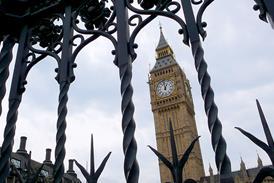- EoE ambulance service sent crews out with very poor oxygen supplies, while SECAmb vehicles ran out of oxygen waiting to hand over patients
- Trusts said they have now resolved supply issues by increasing tank deliveries from main NHS supplier BOC
Ambulance crews in parts of the country hard hit by covid-19 have run very low on oxygen — or out of it entirely — on several occasions in the last month, HSJ has learnt.
HSJ understands East of England Ambulance Service Trust had to dispatch ambulance crews with very limited oxygen supply earlier this month due to strained tank supplies. At one point, crews were sent out with “a single, quarter-full portable oxygen bottle where they used to have at least four portable bottles on the vehicle”, according to one source close to the trust.
Similar shortages have occurred at South East Coast Ambulance Service Foundation Trust. HSJ understands ambulances in this region ran out of oxygen while waiting to hand over patients to accident and emergency departments.
One source working within the region told HSJ: “The oxygen flow is terrible. People are running out of oxygen. A hospital only has a finite flow and need is exceeding what a hospital is built to deliver, so then they have oxygen tanks outside which are being used up too.
Ambulances are waiting so long to discharge patients that they are using up all their oxygen they carry and people are then on low [oxygen saturations] until they can come into the department.”
A SECAmb spokesman said: “Our logistics team is closely monitoring our oxygen stock levels to ensure we have sufficient oxygen to treat patients across our region. We are also working closely with our supplier and, where necessary, increasing deliveries.”
However, the trust did not confirm if the shortages were due to a lack of available tanks on board or long A&E handover queues causing tanks to run dry. It also did not identify at which or at how many hospitals the issues were occuring at.
NHS England data, published on Thursday, revealed hour-plus ambulance handovers reached a three-year high of 5,513 last week.
Meanwhile, HSJ understands East of England Ambulance Service resolved its shortages within the last week by changing its delivery schedule with its supplier BOC, increasing the number of oxygen tank deliveries from two to five a week.
BOC, the main oxygen tank supplier to the NHS, said in a statement on its website that, due to increased demand, it has now “implemented a full for empty supply of medical oxygen cylinder gases to ensure that supplies can be maintained and fairly distributed to all customers”.
This means, in many cases, ambulances can no longer hold reserves in their depots as they usually would.
The statement added BOC had “maintained hospital stock levels on average above 80 per cent” and also “returned to the standard fill point level on medical liquid oxygen vessels” after agreement with the Department of Health and Social Care to reinstate this capacity. It said this decision “is constantly being reviewed and will be amended in accordance with guidance from DHSC”.
Alan Howson, Independent Ambulance Association executive chair, said some of his members have seen a “threefold increase” in the need for oxygen cylinders, with reports that some have now used all their reserve oxygen cylinders. He said the lack of additional cylinders “risks vehicles either not being put out or going out without oxygen”.
Mr Howson also said that, in the first wave, some of his members tried to increase the number of vehicles they had on the road but were delayed in doing so, as there were not enough oxygen cylinders available.
He said: “The situation was resolved reasonably quickly but looks like it is repeating during the current covid wave as demand is much higher.”
NHSE was approached for comment, while BOC was invited to comment further.
Source
HSJ interviews
Source Date
January 2021



























3 Readers' comments